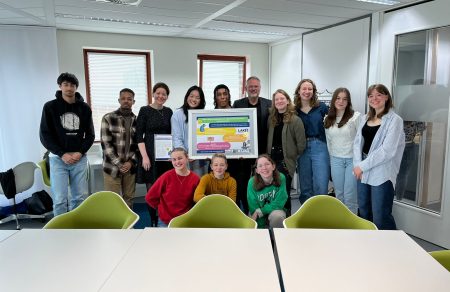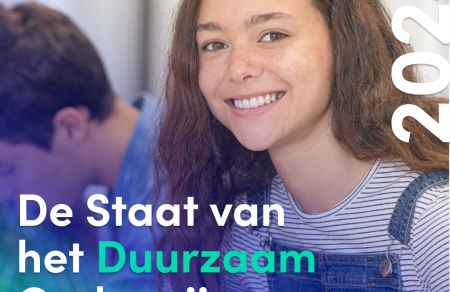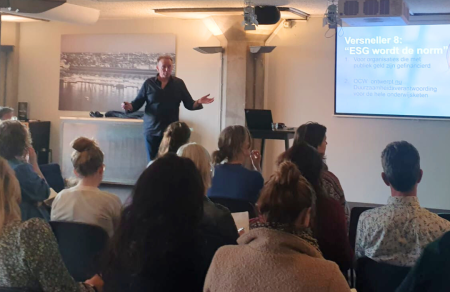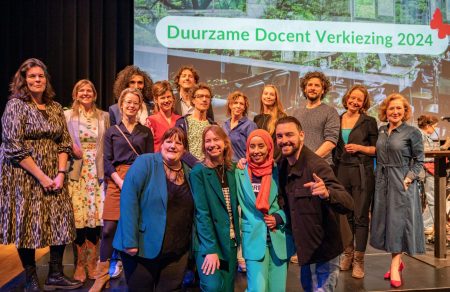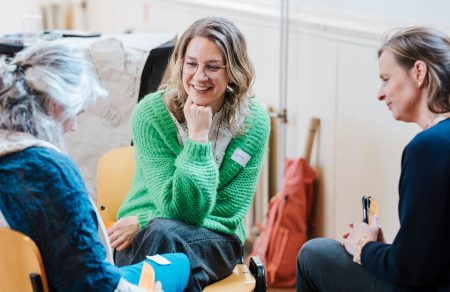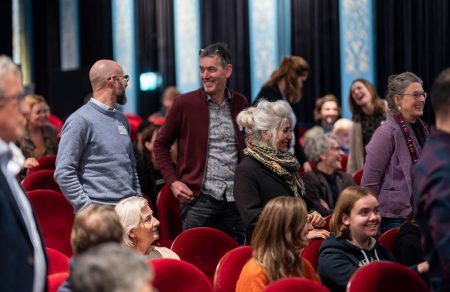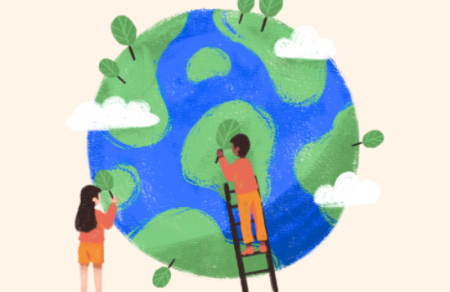From thrift store to sustainable fashion
With a background in (international) trade, it is not immediately obvious to start working at a practical school in Rijswijk. Yet Nawfal did, after the Stanislas Pro's management asked him to take a look at the school's thrift store, which was not running well.
He quickly saw why: "The store had absolutely nothing from commerce or economics that I would want to teach students about. There was no purchasing or sales policy, for example." Pleasant reason for him and the management to do things differently.
The collection of porcelain kittens and unmade puzzles disappeared first to make room. After the store was cleared out, he asked the students: what do you feel like working in and with? A sports-fashion shop, that seemed like something for them, so Nawfal and colleagues set to work on that.
He took on the procurement task himself. "Then the question did occur to me: how are we going to do that sustainably? Because the clothing industry is the second most polluting industry in the world. So it had to be about Sustainable Fashion."
Teachers bring specific knowledge from practice into the school
At every step around setting up the business, Nawfal takes the students with him and enlists experts in the field: learning masters. These could be people who design names and logos, or someone who knows all about upcycling clothing. These learning masters bring different knowledge, and this allows Nawfal to pay more attention to the level differences in the class.
Sustainability is also reflected in all aspects of business. "We look at sustainability in everything we do, for example, in the working conditions, the materials and the environmental aspects of it."
He literally shows his students where leftover unsold clothing remains and that they pay way too much money for fashion brands. This is all part of bringing the real world inside.
To be able to do this and pay the learning masters, among other things, requires more money than is normally available in the school. How do you do that?
"We want to engage in a three-year pilot with partners such as Talent Development Foundation, Cooperative Learning for Tomorrow and Cooperative Doon. One of the questions is how you can use the lump sum in such a way that the school can, for example, use learning masters to combat the teacher shortage and at the same time increase subject knowledge in the classroom. I hope that in that pilot we can demonstrate that it is really necessary to redesign lump sum so that this form of learning has a proper place. "
As an entrepreneur, Nawfal also ran into other roadblocks in the school system. "I was used to determining the steps myself, finding my way to reach my goal. But in a school environment, different rules apply and the pace is different. That's where I did have to slow down." One of the solutions Nawfal sees is to legally separate the business from the school so that they can start teaching courses there, including in the evenings. Young people should also be able to do internships there, Nawfal says. In this way, Nawfal is looking for opportunities in this pilot to turn the thrift store into a real social enterprise.
Tip: give teachers more space to look around at companies in their industry
It is actually quite crazy that subject teachers get so little time to delve into their field, to see what is going on in their industry. Whether that's construction or fashion: what technologies are being used, what are the themes? In fact, why shouldn't you be allowed to work at a company for a while, one day a week?
Dealing with resistance
Colleagues are not always eager to adopt a whole new methodology. Sometimes there is outright resistance. Nawfal says: "I often hear 'that will never work'. The only thing I can say in return is: 'watch me do it'. I also invite colleagues to watch or to attend events together about sustainable education. I now notice that this is starting to have an effect. So just keep going and help those who are enthusiastic."
Liedewij de Graaf (Circulate Foundation) agrees. "A large group of teachers really wants to change, but doesn't have the time or doesn't really know where to start. Precisely those teachers we need to facilitate."
Getting students excited: old clothes become cool
At Nawfal, pants and hoodies are customized by students. Thus, they become unique, cool, garments.
"We are currently doing this by printing used t-shirts or hoodies around the theme of Heritage, ancestors. To get students started, I first made an example of my own Iraqi heritage: an image depicting the Assyrian civilization. This inspires them to make their own designs as well; without an example, something so totally new is too abstract for them."
This is also where Nawfal makes the link between education and the outside world. Nawfal and the other participants in the meeting emphasize how important it is to show students that - and how - you can make a living in the outside world with sustainable business. That you can earn your money with it. That is why it is so important to go public, with TikTok or Instagram pages, for example.
Discarded furniture repainted suddenly does sell. Clothes that are uniquely made become cool. Vintage sounds very different from thrift. Show students how sustainable value works in the real world and that it is not just a school project.
Reach out, show what you do and what works
The aftertaste of this encounter is that as a school, as a teacher, you should and can reach out to people outside the school. People who are knowledgeable about your profession: involve them in your classroom. Get them as partners in the school in your venture or project and let students experience that their work matters.
Finally, make the impact visible. Nawfal and colleagues hang the SDG goals on one of the walls of their classroom making visible which goals their project is directly contributing to. In this way, students see every day that they are working on the great world goals, through their concrete contribution. This way, sustainable business and learning becomes a party!
